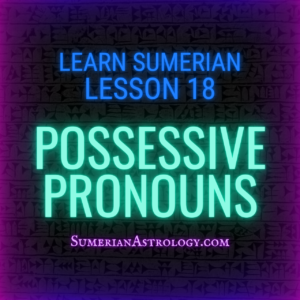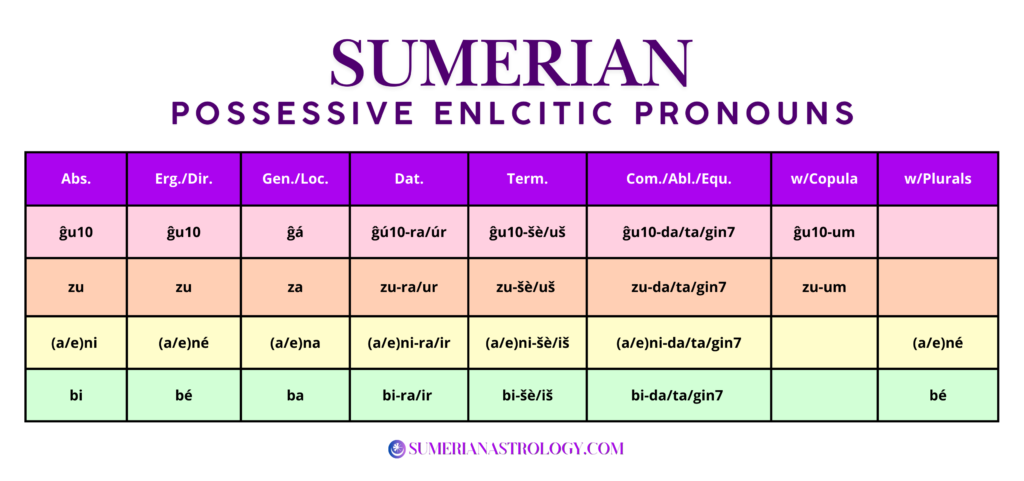Lesson 18
Sumerian Possessive Pronouns
In this lesson, you’ll learn about Sumerian possessive pronouns. To make the lesson appear less intimidating, I didn’t include examples. However, you’ll start seeing these more in the coming lessons, so you’ll get plenty of time to practice!
I highly recommend bookmarking this page for easy reference!
You May Want to Review
Jump to Section
Helpful Terms
Here are some helpful terms you’ll encounter in this lesson. You can see a full list in the Glossary of Terms.
- ablative: a grammatical case which indicates removal or movement away from, as in “from”, as well as methodology, as in “by means of”; marked by -ta 𒋫.
- absolutive (abs.): the standard unaltered grammatical case of a noun, held by the direct object, or the noun experiencing the action.
- comitative: a grammatical case which indicates union or joint activity, as in “with” or “and”; marked by -da 𒁕.
- copula: a verb that connects the subject of a sentence to a subject complement; often the word ‘was’, ‘is’, or ‘will be’.
- dative (dat.): a grammatical case which indicates motion toward someone, as in ‘to/for [a person]’, marked by -ra 𒊏.
- directive: a grammatical case which indicates the impersonal dative object, as in “for/to”; indicates proximity or adjacency, as in “beside”, “upon”, “onto”, and “over”; marked by -e 𒂊. Often referred to as the locative-terminative (loc.-term.) case.
- ergative (erg.): a grammatical case which indicates the agent; the noun doing the action, as in ‘[performed] by’, marked by -e 𒂊.
- directive
- equative: a grammatical case which indicates similarity or equality, as in “like,” or “as”, as well as replacement, as in “instead of”; marked by gin7 𒁶.
- genitive (gen.): a grammatical case which indicates possession, belonging, or origin, as in “of”, marked by -ak 𒀝.
- impersonal (impers.): a class of nouns considered inanimate in Sumerian, such as animals, objects, places, as well as humans of lower social stature, such as slaves and enemies.
- locative (loc.): a grammatical case which indicates where something is happening, as in ‘in’, or ‘at’, marked by -a 𒀀.
- personal (pers.): a class of nouns considered animate; namely deities and humans of high social status (excludes slaves, enemies, etc.).
- terminative: a grammatical case which indicates an end point, as in “(up) to,” “as far as”, or “until,” as well as direction, as in “to(ward)”; marked by -šè 𒂠.
Vocabulary to Memorize
I highly recommend memorizing these Sumerian words, as you’ll encounter them often in the upcoming lessons!
- (a/e)ni (𒀀/𒂊)𒉌 pron., poss. his/her (abs.).
- bi 𒁉 pron., poss., its (impers.) (abs.); their (impers.) (abs.).
- ĝá 𒂷 pron., poss., my (gen., loc.).
- mu 𒈬 n., name; word; oath; year; entry (line on a tablet). v., to name; speak.
- za 𒍝 pron., poss., your (sg.) (gen., loc.).
Vocabulary--Full List
Here are the vocabulary terms for this lesson. Be sure to look them over as they’re updated with additional meanings each lesson. You can see the full Sumerian Lexicon here.
- a 𒀀 n., water; semen; progeny; canal; flood. part., suff., in, at, when (loc.); nominalizing suffix.
- (a/e)ni (𒀀/𒂊)𒉌 pron., poss. his/her (abs.).
- (a/e)ne-ne (𒀀/𒂊)𒉈𒉈 pron., poss., they (pers.) (abs., erg., dir., gen.).
- (a/e)ne-ne-ra/er (𒀀/𒂊)𒉈𒉈𒊏𒅕 pron., poss., they (pers.) dat.).
- bi 𒁉 pron., poss., its (impers.) (abs.); their (impers.) (abs.).
- ĝu10 𒈬 pron., poss., my (abs., erg., dir.).
- ĝá 𒂷 pron., poss., my (gen., loc.).
- lugal 𒈗 n., king; owner, master, lord.
- me 𒈨 n., function, office, responsibility; divine power/decree. pron., poss., our (abs., erg., dir., gen.,) cop., I am (OS); you are (OS, NS); they are (NS). v., to say, tell. adv., where?
- mu𒈬 n., name; word; oath; year; entry (line on a tablet). v., to name; speak.
- za 𒍝 pron., poss., your (sg.) (gen., loc.).
- zu 𒍪 pron., poss., your (sg.) (abs., erg., dir.).
- zu-ne-ne 𒍪𒉈𒉈 pron., poss., your (pl.) (abs., erg., dir., gen.).

Sumerian Possessive Pronouns
Unlike independent personal pronouns, Sumerian possessive pronouns suffix to the noun they’re modifying, as in:
- lugal-ĝu10 𒈗𒈬 my king

Singular Possessive Pronouns
1st Person Singular—My
Depending on the case, “my” can be expressed in a few different ways; all of which are variations of the standard possessive pronoun ĝu10 𒈬.
As you’ll see, some of the following require the appropriate case marker while others do not.
NOTE: The reason why some possessives don’t require a case marker is that the vowel of the postposition is thought to assimilate with the vowel of the pronoun. For example: ĝu10 + a = ĝá. While you don’t need to worry about this now, vowel assimilation is a common phenomenon in Sumerian, and you’ll encounter it frequently.
- ĝu10 𒈬 (absolutive, ergative, directive)—no case-marker necessary
- ĝá 𒂷 (genitive, locative)—no case-marker necessary
- ĝú10-ra/úr 𒈬𒊏/𒌫 (dative)
- ĝu10-šè/uš 𒈬𒂠/𒍑 (terminative)
- ĝu10-da/ta/gin7 𒈬𒁕/𒋫/𒁶 (comitative/ablative/equative)
- ĝu10-um 𒈬𒌝 before the enclitic copula, as in:
- mu-ĝu10-um 𒈬𒈬𒌝 It is my name.
NOTE: As you can see in the dative, terminative, and copular examples above, the /u/ of ĝu10 𒈬 is sometimes followed by a variation of the case marker that starts with /u/. This is a phenomena called ‘vowel harmony’, and it is common in Sumerian.
2nd Person Singular—Your
Depending on the case, “your” can be expressed in a few different ways, all of which are variations of the standard possessive pronoun zu 𒍪.
As you’ll see, some of the following require the appropriate case marker while others do not.
- zu 𒍪 (absolutive, ergative, directive)—no case-marker necessary
- za 𒍝 (genitive, locative)—no case-marker necessary
- zu-ra/ur 𒍪𒊏/𒌫 (dative)
- zu-šè/uš 𒍪𒂠/𒍑 (terminative)
- zu-da/ta/gin7 𒍪𒁕/𒋫/𒁶 (comitative/ablative/equative)
- zu-um 𒍪𒌝 before the enclitic copula
3rd Person Singular (Personal)—His/Her
Depending on the case, “his/her” can be expressed in a few different ways, all of which are variations of the standard possessive pronoun (a/e)ni (𒀀/𒂊)𒉌.
As you’ll see, some of the following require the appropriate case marker while others do not.
NOTE: The /a/ or /e/ is often omitted when preceded by a vowel, especially in the OS period.
- (a/e)ni (𒀀/𒂊)𒉌 (absolutive)—no case marker necessary
- (a/e)né (𒀀/𒂊)𒉌 (ergative, directive, plurals)—no case marker necessary
- (a/e)na (𒀀/𒂊)𒈾 (genitive, locative)—no case marker necessary
- (a/e)ni-ra/ir (𒀀/𒂊)𒉌𒊏/𒅕 (dative)
- (a/e)ni-šè/iš (𒀀/𒂊)𒉌𒂠/𒅖 (terminative)
- (a/e)ni-da/ta/gin7 (𒀀/𒂊)𒉌𒁕/𒋫/𒁶 (comitative/ablative/equative)
3rd Person Singular AND Plural (Impersonal)—Its/Their
Expressing “its” and “their (impersonal)” is done in the exact same way. As you’ll see, all of these are variations of the standard possessive pronoun bi 𒁉.
- bi 𒁉 (absolutive)—no case marker necessary
- bé 𒁉 (ergative, directive, plurals)—no case marker necessary
- ba 𒁀 (genitive, locative)—no case marker necessary
- bi-ra/ir 𒁉𒊏/𒅕 (dative)
- bi-šè/iš 𒁉𒂠/𒅖 (terminative)
- bi-da/ta/gin7 𒁉𒁕/𒋫/𒁶 (comitative/ablative/equative)
Plural Possessive Pronouns
Like their singular counterparts, plural Sumerian possessive pronouns suffix to the noun they’re modifying.
NOTE: The locative case marker -a 𒀀 DOES NOT assimilate to the PLURAL possessive pronouns, as it does to the singular.
1st Person Plural—Our
Depending on the case, “our” can be expressed in a few different ways.
- me 𒈨 (absolutive, ergative, directive, genitive)—no case marker necessary
- me-a 𒈨𒀀 (locative)
- me-ra/da/ta/šè/gin7 𒈨𒊏/𒁕/𒋫/𒂠/𒁶 (dative/comitative/ablative/terminative/equative)
2nd Person Plural—Your (pl.)
Depending on the case, “your (pl.)” can be expressed in a few different ways. As you’ll see, all of these are variations of zu 𒍪 ‘your’, plus the plural suffix (e)ne (𒂊)𒉈.
- zu-ne-ne 𒍪𒉈𒉈 (absolutive, ergative, directive, genitive)
- zu-ne-ne-a 𒍪𒉈𒉈𒀀 (locative)
- zu-ne-ne-ra/er 𒍪𒉈𒉈𒊏𒅕 (dative)
- zu-ne-ne–da/ta/šè/gin7 𒍪𒉈𒉈𒁕/𒋫/𒂠/𒁶 (comitative/ablative/terminative/equative)
3rd Person Plural (Personal)—Their
To express “their” in Sumerian, use the following. As you’ll see, all of these are variations of (a/e)ne (𒀀/𒂊)𒉈 ‘his/her’, plus the plural suffix (e)ne (𒂊)𒉈.
- (a/e)ne-ne (𒀀/𒂊)𒉈𒉈 (absolutive, ergative, directive, genitive)
- (a/e)ne-ne-a (𒀀/𒂊)𒉈𒉈𒀀 (locative)
- (a/e)ne-ne-ra/er (𒀀/𒂊)𒉈𒉈𒊏𒅕 (dative)
- (a/e)ne-ne–da/ta/šè/gin7 (𒀀/𒂊)𒉈𒉈𒁕/𒋫/𒂠/𒁶 (comitative/ablative/terminative/equative)
3rd Person Singular (Impersonal)— Their
See the section above on the 3rd person singular/plural impersonal possessive pronoun.
Your Sumerian Language Journey Continues!
In the next lesson, we’ll tackle Sumerian reflexive pronouns, so be sure to subscribe to my substack to get all of my articles as soon as they post!

